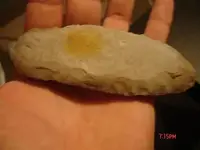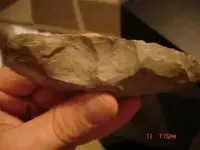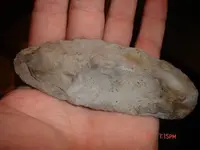You are using an out of date browser. It may not display this or other websites correctly.
You should upgrade or use an alternative browser.
You should upgrade or use an alternative browser.
not sure what this one is
- Thread starter central MO rock stars
- Start date
central MO rock stars
Jr. Member
- #3
Thread Owner
thanks rob i am quite new to this, what makes it a celt and what is it used for? we have a smaller one to i will post later, and quite a bit more stuff that we have found over the years
ShowmeMoflint
Sr. Member
Nice 1 Thanks for the post C M R
TripleCreek
Jr. Member
- Joined
- Jan 27, 2009
- Messages
- 71
- Reaction score
- 2
- Golden Thread
- 0
- Location
- Mid Maryland
- Detector(s) used
- Tesoro- DeLeon
I would say that this is a preform, not a celt. This is "not" to say that this could NOT have be halfted into a handle and used. If you look at the first picture, you will see that the preform has be "capped", It's like taking the top off a turtle shell off, and similar to taking a fluting flake. This is a way to make a long, thin, and most importantly a "flat" flake, that is perfect for making into a spear or arrowhead point. This can be done several times during the reduction process. The other side still has this flake available to take. This makes the preform unbalance. I think if they had wanted to finish this point into a celt, they would have removed the other side, or more likely, not have "caped" the first side, in the first place, to make a stronger celt.
Rock star, a celt is used just like a modern hatchet, to shape and chop wood, trees etc. It is called a celt, to distinguish it from a grooved ax, which was halfted in a differant way to a wood handle. The "celt" was halfted by a "compression fit" into a hole, that was chiseled and burned into the wood handle. No adhisive was used in the halfting of a celt. The grooved ax, was halfted by wrapping a green leam around the grove, and then bound with adhesive and a raw hide strap.
3creeks
Rock star, a celt is used just like a modern hatchet, to shape and chop wood, trees etc. It is called a celt, to distinguish it from a grooved ax, which was halfted in a differant way to a wood handle. The "celt" was halfted by a "compression fit" into a hole, that was chiseled and burned into the wood handle. No adhisive was used in the halfting of a celt. The grooved ax, was halfted by wrapping a green leam around the grove, and then bound with adhesive and a raw hide strap.
3creeks
Similar threads
- Suggestion
- Replies
- 5
- Views
- 533
- Replies
- 0
- Views
- 181
- Replies
- 3
- Views
- 291
Users who are viewing this thread
Total: 1 (members: 0, guests: 1)




